Vector network analyzers
-
Top salesExpert's choice
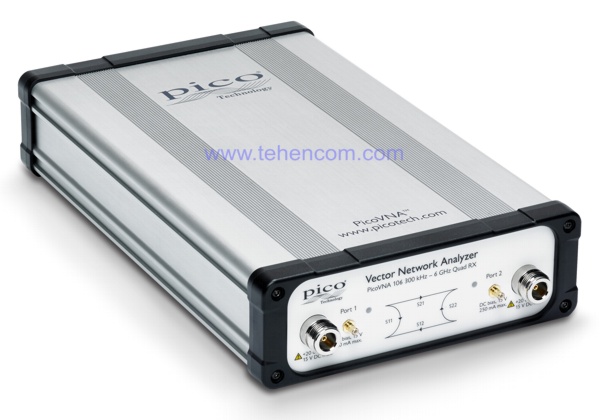 Pico Technology PicoVNA 108
Pico Technology PicoVNA 108Vector network analyzer, 8.5 GHz, 2 ports, 124 dB, 100 µs per point
Price on request
On order
Product code: 1000131
Network analysis: 300 kHz – 8.5 GHz
Output power: From -20 dBm to +10 dBm
Directivity: 40 dB 47 dB
Inexpensive vector network analyzer up to 8.5 GHz with good accuracy and USB control.
-
PromotionExpert's choice
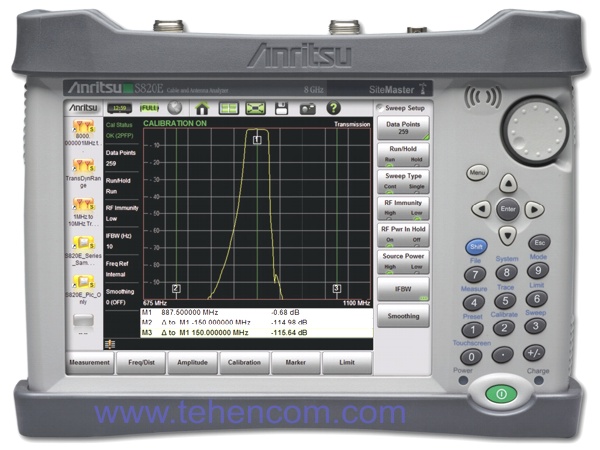 Anritsu S820E-0720
Anritsu S820E-0720Antenna analyzer, 20 GHz, 1 or 2 ports, 100 dB, 550 µs per point
Price on request
On order
Product code: 1000137
Network analysis: 1 MHz – 20 GHz
Output power: +5 dBm -20 dBm
Directivity: 42 dB
Antenna analyzer with vector network analyzer.
-
Expert's choice
 Anritsu MS4647B
Anritsu MS4647BVector network analyzer, 70 GHz, 2 or 4 ports, 122 dB, 20 µs per point
Price on request
On order
Product code: 1000152
Network analysis: 10 MHz – 70 GHz 70 kHz – 70 GHz
Output power: From -25 dBm to +12 dBm From -85 dBm to +10 dBm
Directivity: 41 dB 50 dB
Vector network analyzer up to 70 GHz with maximum performance.
-
Expert's choice
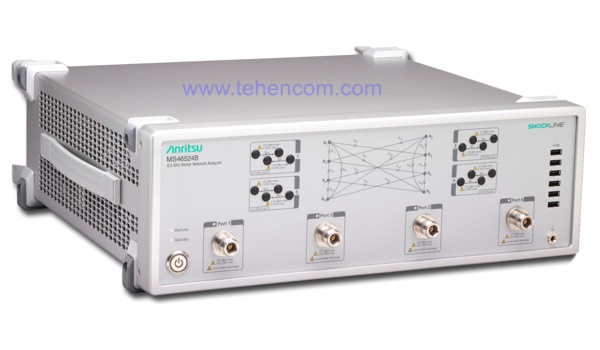 Anritsu MS46524B-040
Anritsu MS46524B-040Vector network analyzer, 43.5 GHz, 4 ports, 140 dB, 30 µs per point
Price on request
On order
Product code: 1000150
Network analysis: 50 kHz – 43.5 GHz
Output power: From -30 dBm to +15 dBm
Directivity: 42 dB 50 dB
-
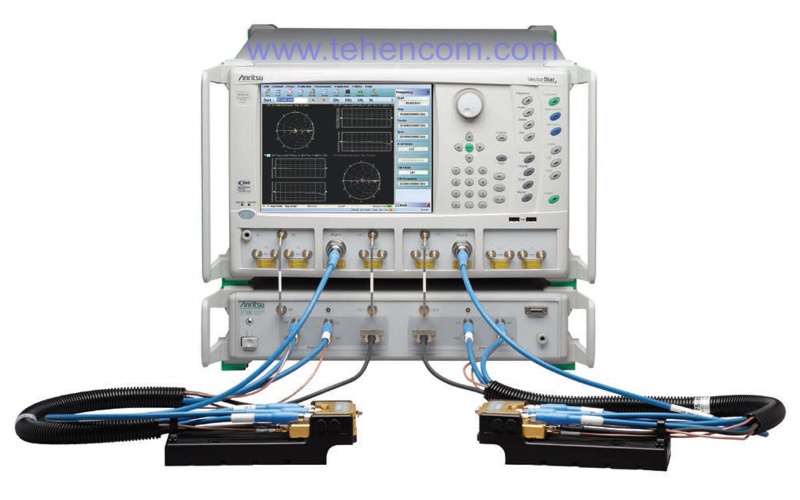 Anritsu ME7838D
Anritsu ME7838DVector network analyzer, 145 GHz, 2 ports, 120 dB, 30 µs per point
Price on request
On order
Product code: 1000154
Network analysis: 70 kHz – 145 GHz
Output power: From -25 dBm to +10 dBm From -85 dBm to +10 dBm
Directivity: 40 dB
-
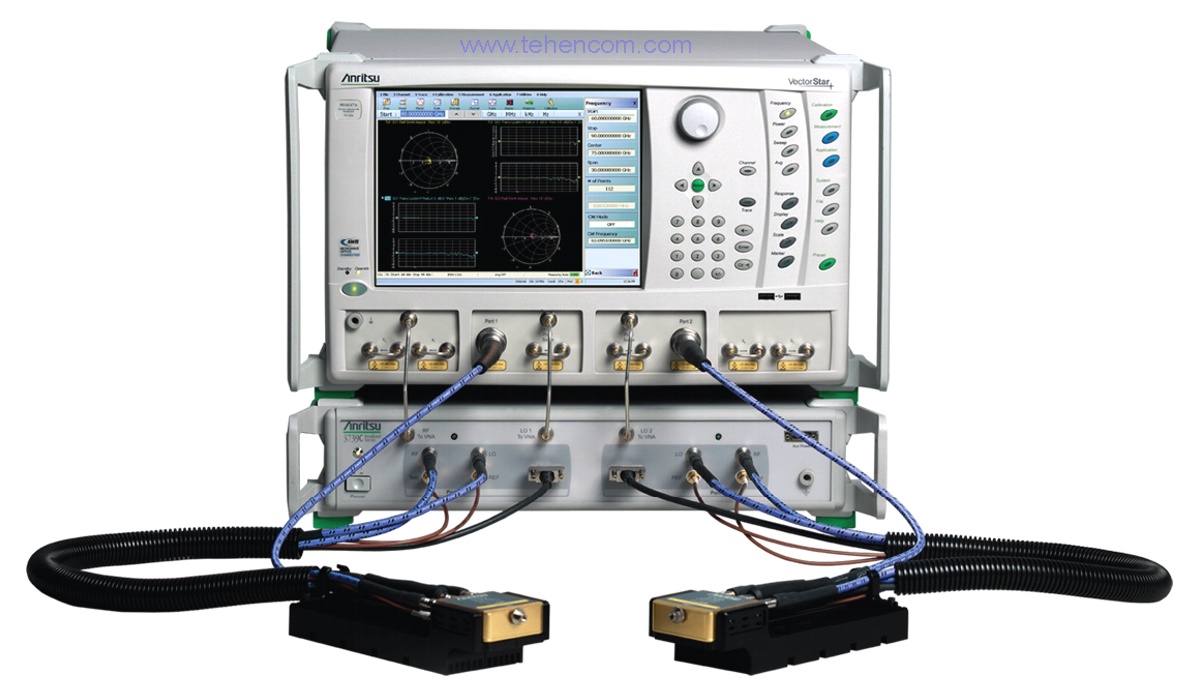 Anritsu ME7838E
Anritsu ME7838EVector network analyzer, 110 GHz, 2 ports, 120 dB, 30 µs per point
Price on request
On order
Product code: 1000153
Network analysis: 70 kHz – 110 GHz
Output power: From -25 dBm to +10 dBm From -85 dBm to +10 dBm
Directivity: 43 dB 50 dB
-
 Anritsu MS4644B
Anritsu MS4644BVector network analyzer, 40 GHz, 2 or 4 ports, 122 dB, 20 µs per point
Price on request
On order
Product code: 1000149
Network analysis: 10 MHz – 40 GHz 70 kHz – 40 GHz
Output power: From -25 dBm to +12 dBm From -95 dBm to +12 dBm
Directivity: 43 dB 50 dB
Vector network analyzer up to 40 GHz with maximum performance.
-
 Anritsu MS4642B
Anritsu MS4642BVector network analyzer, 20 GHz, 2 or 4 ports, 122 dB, 20 µs per point
Price on request
On order
Product code: 1000143
Network analysis: 10 MHz – 20 GHz 70 kHz – 20 GHz
Output power: From -25 dBm to +12 dBm From -95 dBm to +12 dBm
Directivity: 43 dB 50 dB
Vector network analyzer up to 20 GHz with maximum performance.
-
 Anritsu MS46524B-020
Anritsu MS46524B-020Vector network analyzer, 20 GHz, 4 ports, 140 dB, 30 µs per point
Price on request
On order
Product code: 1000142
Network analysis: 50 kHz – 20 GHz
Output power: From -30 dBm to +15 dBm
Directivity: 42 dB 50 dB
-
 Anritsu MS46524B-010
Anritsu MS46524B-010Vector network analyzer, 8.5 GHz, 4 ports, 140 dB, 30 µs per point
Price on request
On order
Product code: 1000132
Network analysis: 50 kHz – 8.5 GHz
Output power: From -30 dBm to +15 dBm
Directivity: 42 dB 50 dB
-
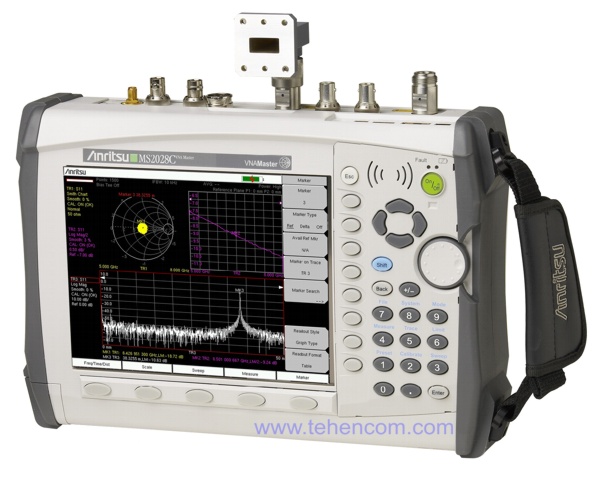 Anritsu MS2036C
Anritsu MS2036CNetwork and spectrum analyzer, 6 GHz, 2 ports, 100 dB, 350 µs per point
Price on request
On order
Product code: 1000127
Network analysis: 5 kHz – 6 GHz
Output power: +3 dBm -25 dBm
Directivity: 42 dB
Spectrum analysis: 9 kHz – 9 GHz
-
 Anritsu MS2035B
Anritsu MS2035BVector network analyzer, 6 GHz, 2 ports, 100 dB, 850 µs per point
Price on request
On order
Product code: 1000125
Network analysis: 500 kHz – 6 GHz
Output power: +3 dBm -5 dBm -25 dBm
Directivity: 42 dB
Spectrum analysis: 9 kHz – 6 GHz
-
 Anritsu MS2025B
Anritsu MS2025BVector network analyzer, 6 GHz, 2 ports, 100 dB, 850 µs per point
Price on request
On order
Product code: 1000124
Network analysis: 500 kHz – 6 GHz
Output power: +3 dBm -5 dBm -25 dBm
Directivity: 42 dB
-
 Pico Technology PicoVNA 106
Pico Technology PicoVNA 106Vector network analyzer, 6 GHz, 2 ports, 118 dB, 100 µs per point
Price on request
On order
Product code: 1000123
Network analysis: 300 kHz – 6 GHz
Output power: From -20 dBm to +6 dBm
Directivity: 40 dB 47 dB
Inexpensive vector network analyzer up to 6 GHz with good accuracy and USB control.
-
 Anritsu MS2034B
Anritsu MS2034BVector network analyzer, 4 GHz, 2 ports, 100 dB, 850 µs per point
Price on request
On order
Product code: 1000121
Network analysis: 500 kHz – 4 GHz
Output power: +3 dBm -5 dBm -25 dBm
Directivity: 42 dB
Spectrum analysis: 9 kHz – 4 GHz
-
 Anritsu MS2024B
Anritsu MS2024BVector network analyzer, 4 GHz, 2 ports, 100 dB, 850 µs per point
Price on request
On order
Product code: 1000120
Network analysis: 500 kHz – 4 GHz
Output power: +3 dBm -5 dBm -25 dBm
Directivity: 42 dB
-
 Anritsu S820E-0740
Anritsu S820E-0740Antenna analyzer, 40 GHz, 1 or 2 ports, 100 dB, 550 µs per point
Price on request
On order
Product code: 1000146
Network analysis: 1 MHz – 40 GHz
Output power: +5 dBm -20 dBm
Directivity: 42 dB
Antenna analyzer with vector network analyzer.
-
 Anritsu S820E-0730
Anritsu S820E-0730Antenna analyzer, 30 GHz, 1 or 2 ports, 100 dB, 550 µs per point
Price on request
On order
Product code: 1000144
Network analysis: 1 MHz – 30 GHz
Output power: +5 dBm -20 dBm
Directivity: 42 dB
Antenna analyzer with vector network analyzer.
-
 Anritsu S820E-0714
Anritsu S820E-0714Antenna analyzer, 14 GHz, 1 or 2 ports, 100 dB, 550 µs per point
Price on request
On order
Product code: 1000133
Network analysis: 1 MHz – 14 GHz
Output power: +5 dBm -20 dBm
Directivity: 42 dB
Antenna analyzer with vector network analyzer.
-
 Anritsu S820E-0708
Anritsu S820E-0708Antenna analyzer, 8 GHz, 1 or 2 ports, 100 dB, 550 µs per point
Price on request
On order
Product code: 1000128
Network analysis: 1 MHz – 8 GHz
Output power: +5 dBm -20 dBm
Directivity: 42 dB
Antenna analyzer with vector network analyzer.
-
 Anritsu S412E
Anritsu S412ELand mobile radio analyzer, 6 GHz, +26 dBm, DANL -147 dBm
Price on request
On order
Product code: 1000012
Network analysis: 500 kHz – 1.6 GHz 500 kHz – 6 GHz
Output power: +3 dBm -5 dBm -25 dBm
Directivity: 42 dB
Spectrum analysis: 9 kHz – 1.6 GHz 9 kHz – 6 GHz
-
Expert's choice
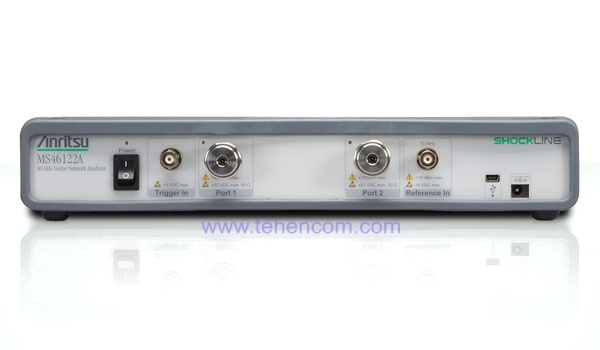 Anritsu MS46122A-040
Anritsu MS46122A-040Vector network analyzer, 43.5 GHz, 2 ports, 100 dB, 220 µs per point
Price on request
Check availability
Product code: 1000147
Network analysis: 1 MHz – 43.5 GHz
Output power: -3 dBm -20 dBm
Directivity: 42 dB 50 dB
Compact 2-port vector network analyzer up to 43.5 GHz with USB control.
-
Expert's choice
 Anritsu MS46122A-020
Anritsu MS46122A-020Vector network analyzer, 20 GHz, 2 ports, 100 dB, 220 µs per point
Price on request
Check availability
Product code: 1000140
Network analysis: 1 MHz – 20 GHz
Output power: -3 dBm -20 dBm
Directivity: 42 dB 50 dB
Compact 2-port vector network analyzer up to 20 GHz with USB control.
-
 Anritsu MS4645B
Anritsu MS4645BVector network analyzer, 50 GHz, 2 or 4 ports, 122 dB, 20 µs per point
Price on request
Check availability
Product code: 1000151
DiscontinuedRecommended replacement: Anritsu MS4647B
Network analysis: 10 MHz – 50 GHz 70 kHz – 50 GHz
Output power: From -25 dBm to +12 dBm From -85 dBm to +10 dBm
Directivity: 41 dB 50 dB
Vector network analyzer up to 50 GHz with maximum performance.
-
 Anritsu MS46322A-040
Anritsu MS46322A-040Vector network analyzer, 43.5 GHz, 2 ports, 100 dB, 220 µs per point
Price on request
Check availability
Product code: 1000148
Network analysis: 1 MHz – 43.5 GHz
Output power: -3 dBm -20 dBm
Directivity: 42 dB 50 dB
-
 Anritsu MS46322A-030
Anritsu MS46322A-030Vector network analyzer, 30 GHz, 2 ports, 100 dB, 220 µs per point
Price on request
Check availability
Product code: 1000145
Network analysis: 1 MHz – 30 GHz
Output power: -3 dBm -20 dBm
Directivity: 42 dB 50 dB
-
 Anritsu MS46322A-020
Anritsu MS46322A-020Vector network analyzer, 20 GHz, 2 ports, 100 dB, 220 µs per point
Price on request
Check availability
Product code: 1000141
Network analysis: 1 MHz – 20 GHz
Output power: -3 dBm -20 dBm
Directivity: 42 dB 50 dB
-
 Anritsu MS46322A-014
Anritsu MS46322A-014Vector network analyzer, 14 GHz, 2 ports, 100 dB, 220 µs per point
Price on request
Check availability
Product code: 1000134
Network analysis: 1 MHz – 14 GHz
Output power: -3 dBm -20 dBm
Directivity: 42 dB 50 dB
-
 Anritsu MS46322A-010
Anritsu MS46322A-010Vector network analyzer, 8 GHz, 2 ports, 100 dB, 220 µs per point
Price on request
Check availability
Product code: 1000130
Network analysis: 1 MHz – 8 GHz
Output power: -3 dBm -20 dBm
Directivity: 42 dB 50 dB
-
 Anritsu MS46122A-010
Anritsu MS46122A-010Vector network analyzer, 8 GHz, 2 ports, 100 dB, 220 µs per point
Price on request
Check availability
Product code: 1000129
Network analysis: 1 MHz – 8 GHz
Output power: -3 dBm -20 dBm
Directivity: 42 dB 50 dB
Compact 2-port vector network analyzer up to 8 GHz with USB control.
-
 Anritsu MS46322A-004
Anritsu MS46322A-004Vector network analyzer, 4 GHz, 2 ports, 100 dB, 220 µs per point
Price on request
Check availability
Product code: 1000122
Network analysis: 1 MHz – 4 GHz
Output power: -3 dBm -20 dBm
Directivity: 42 dB 50 dB
-
 Anritsu MS2038C
Anritsu MS2038CNetwork and spectrum analyzer, 20 GHz, 2 ports, 100 dB, 350 µs per point
Price on request
Not available
Product code: 1000139
DiscontinuedNetwork analysis: 5 kHz – 20 GHz
Output power: +3 dBm -25 dBm
Directivity: 42 dB
Spectrum analysis: 9 kHz – 20 GHz
-
 Anritsu MS2028C
Anritsu MS2028CVector network analyzer, 20 GHz, 2 ports, 100 dB, 350 µs per point
Price on request
Not available
Product code: 1000138
DiscontinuedNetwork analysis: 5 kHz – 20 GHz
Output power: +3 dBm -25 dBm
Directivity: 42 dB
-
 Anritsu MS2037C
Anritsu MS2037CNetwork and spectrum analyzer, 15 GHz, 2 ports, 100 dB, 350 µs per point
Price on request
Not available
Product code: 1000136
DiscontinuedNetwork analysis: 5 kHz – 15 GHz
Output power: +3 dBm -25 dBm
Directivity: 42 dB
Spectrum analysis: 9 kHz – 15 GHz
-
 Anritsu MS2027C
Anritsu MS2027CVector network analyzer, 15 GHz, 2 ports, 100 dB, 350 µs per point
Price on request
Not available
Product code: 1000135
DiscontinuedNetwork analysis: 5 kHz – 15 GHz
Output power: +3 dBm -25 dBm
Directivity: 42 dB
-
 Anritsu MS2026C
Anritsu MS2026CVector network analyzer, 6 GHz, 2 ports, 100 dB, 350 µs per point
Price on request
Not available
Product code: 1000126
DiscontinuedRecommended replacement: Anritsu MS2036C
Network analysis: 5 kHz – 6 GHz
Output power: +3 dBm -25 dBm
Directivity: 42 dB
General information
Network analyzers are designed to evaluate the impedance or scattering and reflection characteristics of active and passive devices such as antennas, amplifiers, filters, frequency converters, switches, attenuators and many other components used in various systems.
Vector network analyzers (VNA) are the most powerful in their group, as they measure a full set of amplitude and phase characteristics of devices. These parameters include: S-parameters, transfer functions, amplitude and phase, standing wave ratio (SWR), insertion loss or gain, attenuation, group delay, return loss or reflection coefficient. Modern vector analyzers usually allow measurements in the frequency range up to 43 GHz, some models provide an upper range of 70 GHz, and with additional modules the upper range can be extended to 145 GHz and higher.
Best models
This table contains the best models of vector network analyzers with the status of Top sales or Expert's choice. Such models have a high price / capability ratio, so they should be paid attention first of all. The table is interactive, any column can be sorted in ascending or descending order.
| Model |
Maximum frequency
|
Minimum frequency
|
Number of ports
|
Dynamic range
|
Measurement speed
|
Weight
|
|---|---|---|---|---|---|---|
|
Top sales
Expert's choice
|
8.5 GHz | 300 kHz | 2 | 124 dB | 100 µs/point | 1.9 kg |
|
Expert's choice
|
20 GHz | 1 MHz | 2 | 100 dB 115 dB | 220 µs/point | 2.2 kg |
|
Expert's choice
|
43.5 GHz | 1 MHz | 2 | 100 dB 115 dB | 220 µs/point | 2.2 kg |
|
Expert's choice
|
43.5 GHz | 50 kHz | 4 | 140 dB 144 dB | 30 µs/point | 15.9 kg |
|
Expert's choice
|
70 GHz | 10 MHz 70 kHz | 2 4 | 122 dB 142 dB | 20 µs/point | 30 kg |
All models of vector network analyzers
This table shows all models of vector network analyzers (VNA). You can sort by any of the characteristics by simply clicking on its name in the table. To see all the characteristics of certain models, add them to the comparison.
| Model |
Maximum frequency
|
Minimum frequency
|
Number of ports
|
Dynamic range
|
Measurement speed
|
Weight
|
|---|---|---|---|---|---|---|
| 4 GHz | 500 kHz | 2 | 100 dB | 850 µs/point | 3.5 kg | |
| 4 GHz | 500 kHz | 2 | 100 dB | 850 µs/point | 3.5 kg | |
| 4 GHz | 1 MHz | 2 | 100 dB 115 dB | 220 µs/point | 11 kg | |
| 6 GHz | 300 kHz | 2 | 118 dB | 100 µs/point | 1.85 kg | |
| 6 GHz | 500 kHz | 2 | 100 dB | 850 µs/point | 3.5 kg | |
| 6 GHz | 500 kHz | 2 | 100 dB | 850 µs/point | 3.5 kg | |
| 6 GHz | 5 kHz | 2 | 100 dB | 350 µs/point | 4.8 kg | |
| 8 GHz | 1 MHz | 2 | 100 dB 115 dB | 220 µs/point | 2.2 kg | |
| 8 GHz | 1 MHz | 2 | 100 dB 115 dB | 220 µs/point | 11 kg | |
|
Top sales
Expert's choice
|
8.5 GHz | 300 kHz | 2 | 124 dB | 100 µs/point | 1.9 kg |
| 8.5 GHz | 50 kHz | 4 | 140 dB 144 dB | 30 µs/point | 13.6 kg | |
| 14 GHz | 1 MHz | 2 | 100 dB 115 dB | 220 µs/point | 11 kg | |
|
Expert's choice
|
20 GHz | 1 MHz | 2 | 100 dB 115 dB | 220 µs/point | 2.2 kg |
| 20 GHz | 1 MHz | 2 | 100 dB 115 dB | 220 µs/point | 11 kg | |
| 20 GHz | 50 kHz | 4 | 140 dB 144 dB | 30 µs/point | 15.9 kg | |
| 20 GHz | 10 MHz 70 kHz | 2 4 | 122 dB 142 dB | 20 µs/point | 30 kg | |
| 30 GHz | 1 MHz | 2 | 100 dB 115 dB | 220 µs/point | 11 kg | |
|
Expert's choice
|
43.5 GHz | 1 MHz | 2 | 100 dB 115 dB | 220 µs/point | 2.2 kg |
| 43.5 GHz | 1 MHz | 2 | 100 dB 115 dB | 220 µs/point | 11 kg | |
| 40 GHz | 10 MHz 70 kHz | 2 4 | 122 dB 142 dB | 20 µs/point | 30 kg | |
|
Expert's choice
|
43.5 GHz | 50 kHz | 4 | 140 dB 144 dB | 30 µs/point | 15.9 kg |
|
Expert's choice
|
70 GHz | 10 MHz 70 kHz | 2 4 | 122 dB 142 dB | 20 µs/point | 30 kg |
| 110 GHz | 70 kHz | 2 | 120 dB | 30 µs/point | 34 kg | |
| 145 GHz | 70 kHz | 2 | 120 dB | 30 µs/point | 34 kg |
Additional equipment
Typically, when working with a network analyzer, calibration kits and various accessories are used. This additional equipment is presented in the section: microwave accessories. Also note that most analyzer models can be equipped with additional useful options that significantly expand the functionality of the device, but at the same time, increase its cost.
Manufacturers of measuring equipment regularly develop and launch new models of vector network analyzers with expanded capabilities and improved performance. Some time after the start of sales of new models, old models and series are discontinued. A complete list of discontinued network analyzers, including proposed replacements, can be found here: discontinued network analyzers.
Video reviews
Better to see once than hear a hundred times. This video collection from our YouTube channel is dedicated exclusively to vector network analyzers: new products, interesting models, features of their application, standards and measurement techniques. We constantly update and supplement this collection with new interesting materials on network analysis and related topics. Subscribe to our channel to stay updated: YouTube channel of Tehencom.
Basic theory
Buying an inexpensive and high-quality vector network analyzer is not always easy. When choosing a model, in addition to the standard parameters: frequency range and number of ports, it is necessary to take into account additional characteristics and capabilities of the analyzer: dynamic range, measurement accuracy, measurement speed, resolution, source power, directivity, calibration modes, possibility and ease of programming, built-in digital interfaces, a set of additional functions, operating temperature range, quality and durability of the device, the reputation of the manufacturer, the professionalism and reliability of the supplier, the availability of a service center, warranty period and much more. In addition, you may need technical advice on additional accessories: calibration elements, phase-stable cables, waveguides and adapters.
The next section Documentation contains useful information on the theory and practice of using vector network analyzer, which will help you understand this issue and improve your professional level. For complex and unclear issues, write to us by e-mail or call, we will be happy to advise.
Calibrating the vector network analyzer
Selecting accessories for a vector network analyzer
Measuring the shielding effectiveness of materials up to 90 GHz
Documentation and useful materials
-
Tutorial on vector network analysis
EN, 62 pages, 5 MB
-
Vector network analysis reference poster
EN, 1 page, 14 MB
-
RF & Microwave measurements reference poster
EN, 1 page, 7 MB